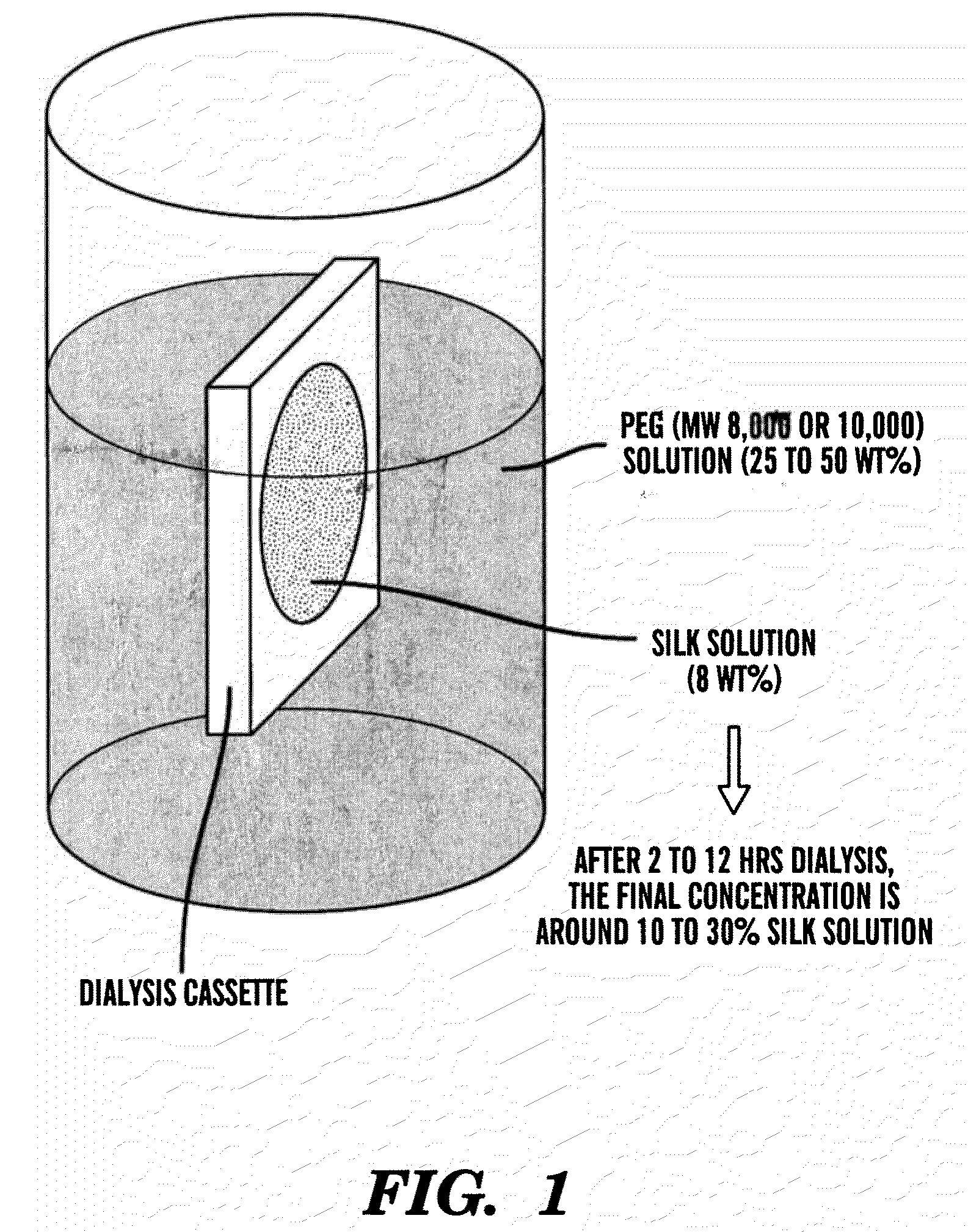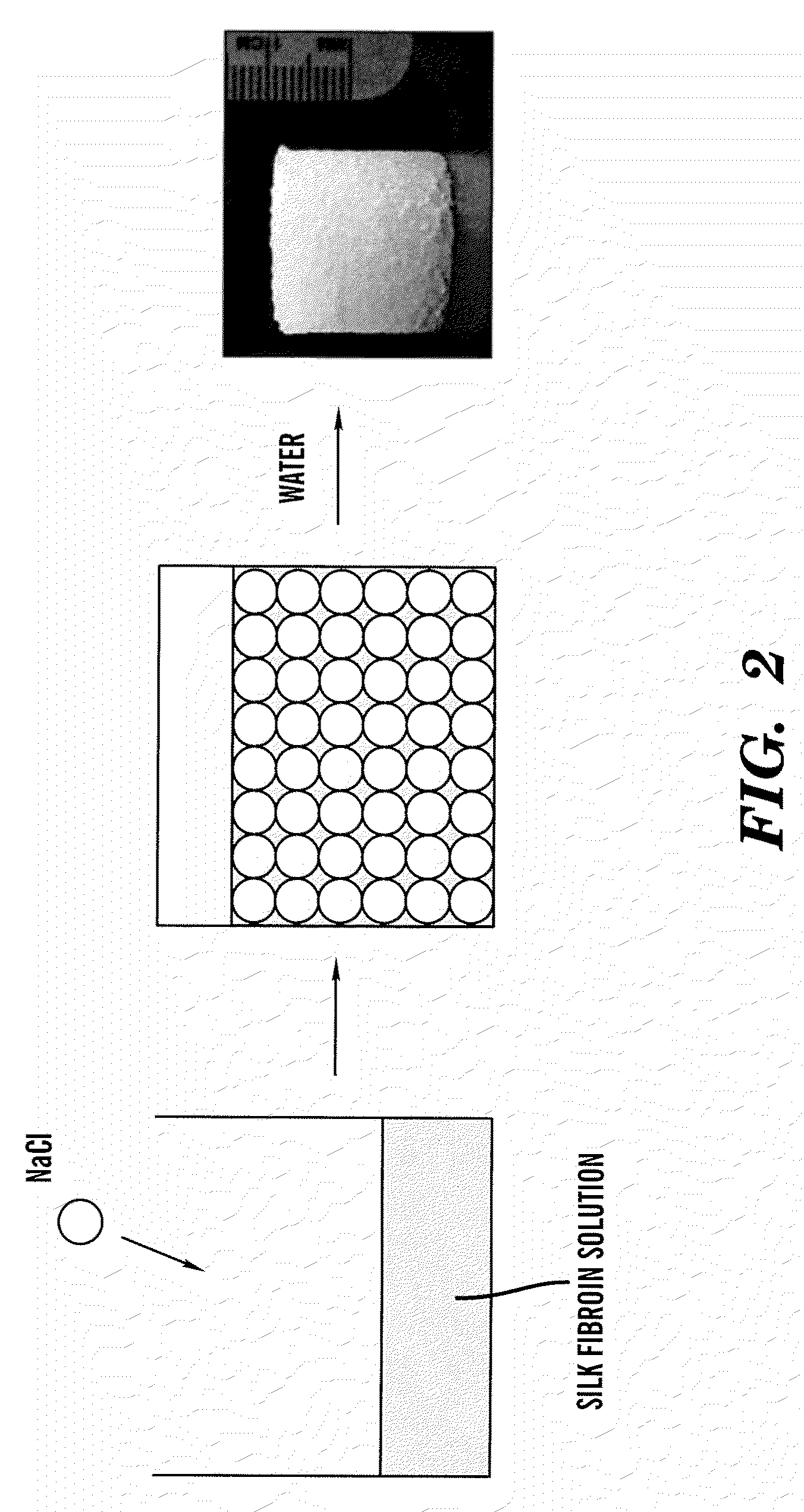Concentrated aqueous silk fibroin solution and use thereof
a technology of concentrated aqueous silk fibroin and solution, which is applied in the direction of filament/thread forming, peptides, prosthesis, etc., can solve the problems of loss of solubility in water and use of organic solvents in the preparation of silk fibroin materials, and achieve the effect of avoiding us
- Summary
- Abstract
- Description
- Claims
- Application Information
AI Technical Summary
Benefits of technology
Problems solved by technology
Method used
Image
Examples
example i
Preparation of Pure Silk Fibers from Water from Regenerated Silk Solution by Electrospinning
Methods
Preparation of a Regenerated B. Mori Silk Fibroin Solution
[0083]B. mori silk fibroin was prepared as follows as a modification of our earlier procedure (Sofia, et al., Journal of Biomedical Materials Research 2001, 54, 139-148). Cocoons were boiled for 30 min in an aqueous solution of 0.02 M Na2CO3, then rinsed thoroughly with water to extract the glue-like sericin proteins. The extracted silk was then dissolved in 9.3 M LiBr solution at room temperature yielding a 20% (w / v) solution. This solution was dialyzed in water using a Slide-a-Lyzer dialysis cassette (Pierce, MWCO 2000) for 48 hours. The final concentration of aqueous silk solution was 8.0 wt %, which was determined by weighing the remaining solid after drying.
[0084]This solution was concentrated further by exposure to an aqueous polyethylene glycol (PEG) (MW 8,000 to 10,000) solution (25-50 wt %) on the outside of a Slide-a-L...
example ii
Preparation of Silk Fibroin Scaffolds
[0086]Porous three-dimensional scaffolds were prepared from silk fibroin aqueous solutions by salt-leaching. By adjusting the concentration of silk fibroin and the particle size of granular NaCl, the morphological and functional properties of the scaffolds could be controlled. The scaffolds had highly homogeneous and interconnected pores and showed pore sizes ranging from 470 to 940 um depending on the mode of preparation. The scaffolds had porosities >90%. The compressive strength and modulus of scaffolds was up to 320±10 KPa and 3330±500 KPa, respectively. The scaffolds were fully degraded by protease during 21 days. These new silk-based 3-D matrices provide useful properties as biomaterial matrices for tissue engineering due to the all-aqueous mode of preparation, control of pore size, connectivity of pores, degradability and useful mechanical features.
Methods
Preparation of Silkfibroin Aqueous Solution
[0087]Cocoons of B. mori were boiled for 2...
example iii
Preparation of Silk Hydrogels
[0111]Control of silk fibroin concentration in aqueous solutions via osmotic stress was studied to assess relationships to gel formation and structural, morphological and functional (mechanical) changes associated with this process. Environmental factors potentially important in the in vivo processing of aqueous silk fibroin were also studied to determine their contributions to this process. Gelation of silk fibroin aqueous solutions was affected by temperature, Ca2+, pH and polyethylene oxide (PEO). Gelation time decreased with increase in protein concentration, decrease in pH, increase in temperature, addition of Ca2+ and with the addition of PEO. No change of gelation time was observed with the addition of K+. Upon gelation, a random coil structure of the silk fibroin was transformed into β-sheet structure. Hydrogels with fibroin concentrations >4 weight percent exhibited network and sponge-like structures based on scanning electron microscopy. Pore s...
PUM
| Property | Measurement | Unit |
|---|---|---|
| particle sizes | aaaaa | aaaaa |
| thick | aaaaa | aaaaa |
| diameter | aaaaa | aaaaa |
Abstract
Description
Claims
Application Information
 Login to View More
Login to View More - R&D
- Intellectual Property
- Life Sciences
- Materials
- Tech Scout
- Unparalleled Data Quality
- Higher Quality Content
- 60% Fewer Hallucinations
Browse by: Latest US Patents, China's latest patents, Technical Efficacy Thesaurus, Application Domain, Technology Topic, Popular Technical Reports.
© 2025 PatSnap. All rights reserved.Legal|Privacy policy|Modern Slavery Act Transparency Statement|Sitemap|About US| Contact US: help@patsnap.com



